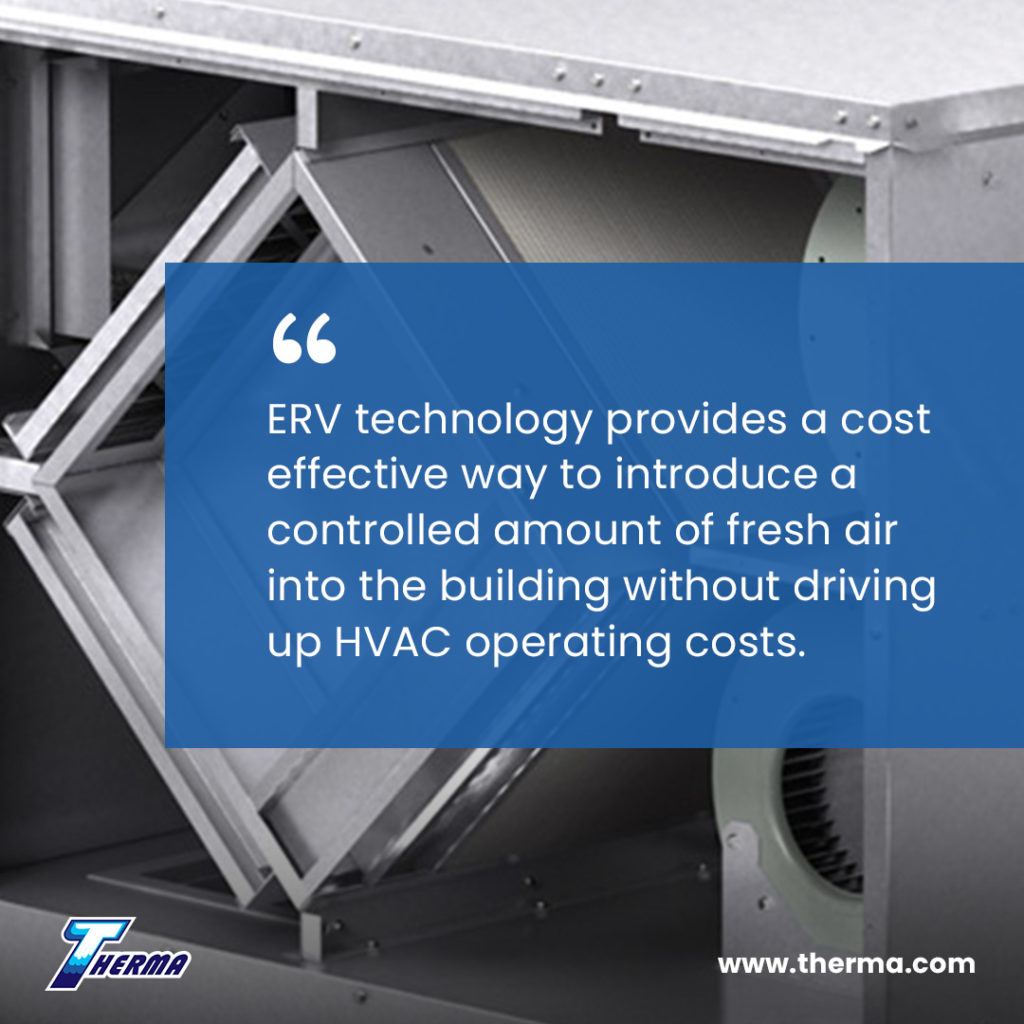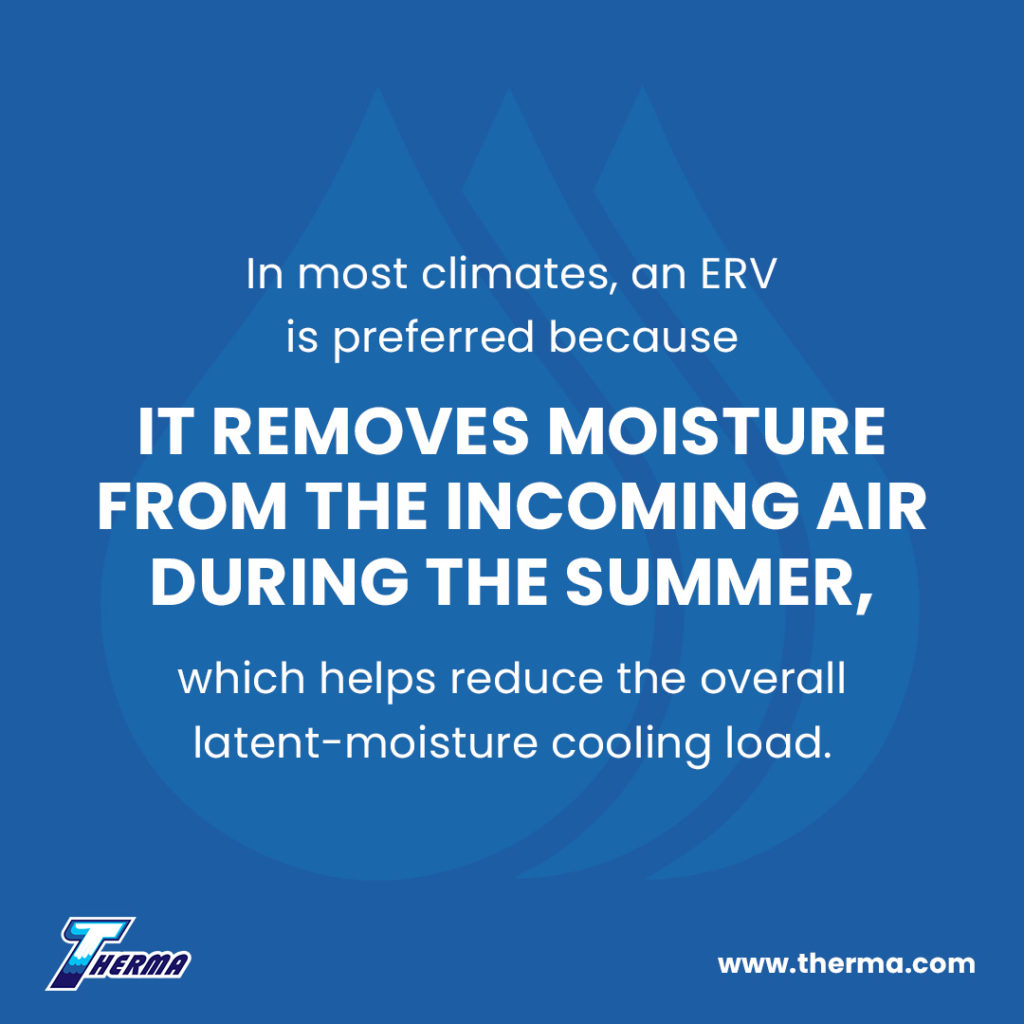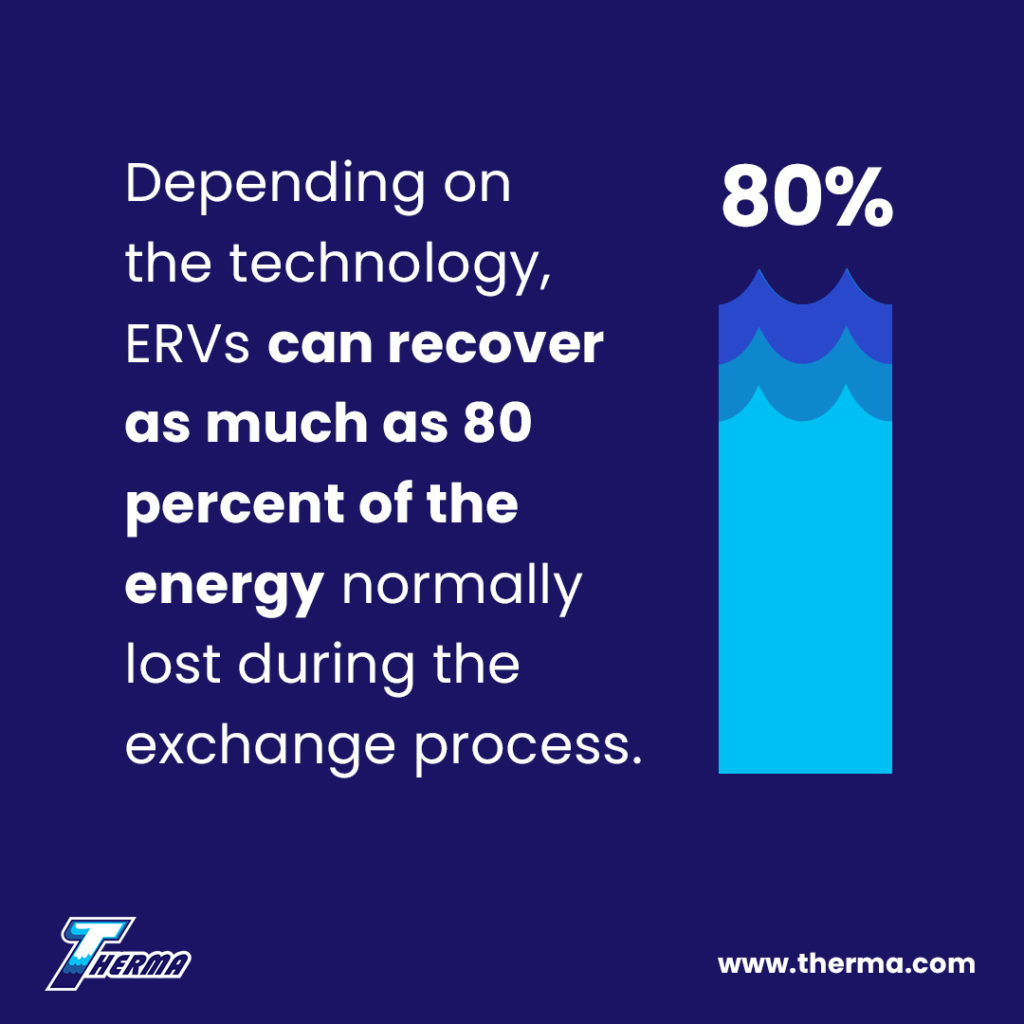National, state and local building codes mandate strict energy efficiency standards, so modern commercial buildings are designed and constructed with minimal natural air infiltration. While the utility savings and reductions in fossil fuel emissions are usually significant, contaminants can accumulate in the occupied area and create indoor air quality issues. Fortunately, energy recovery ventilator (ERV) technology provides owners, administrators and managers with a cost effective way to introduce a controlled amount of fresh air into the building without driving up HVAC operating costs.

How Energy Recovery Ventilators Work
In tight buildings, stale indoor air must be exchanged with fresh outdoor air in amounts prescribed by AHRAE standard 90.1. [1] Indoor air in a commercial environment is often affected by odors, excessive moisture, particulate matter and fumes that can negatively impact occupant health and the structure itself. These toxins must be removed through a ventilation process that replaces tainted indoor air with equal amounts of fresh outdoor air.
Older ventilators simply flushed out the contaminated indoor air while drawing in fresh air from outdoors, but these systems were inefficient since the energy stored in the conditioned air was lost during the exchange process. Until the introduction of ERVs, there was little that could be done to compensate for this energy loss except to adjust the thermostat, which only drove power and fuel costs higher. ERVs were designed to address these comfort and HVAC operating cost deficits by recapturing a portion of this wasted energy.
Energy Recovery Versus Heat Recovery
There are two basic approaches to recovering energy through air exchange. Both methods use a configuration that simultaneously sends incoming and outgoing airstreams through specialized media. While the two streams of air do not mix, depending on the season, either heating or cooling energy is transferred. Heat recovery ventilators (HRVs) can only recapture sensible (dry) energy. Conversely, ERVs employ an enthalpy process that recovers both sensible and latent (moisture) energy.

Ultimately, this helps improve comfort and lowers operating costs. However, it’s important to understand that an ERV will not actually reduce indoor relative humidity. The major advantage of an ERV in a humid climate is that the incoming air will be less saturated with moisture when compared to an HRV. In the winter, ERVs pull humidity from the exhaust air and transfer it to the incoming fresh air, which may eliminate the need for artificial humidification.
Energy Recovery Ventilators Technology

Depending on the technology, ERVs can recover as much as 80 percent of the energy normally lost during the exchange process. [2] Introducing pre-tempered air into an air conditioning unit reduces the total capacity required to cool the building. Estimates show the savings gained from reducing a single-zone rooftop air conditioner from 20 tons to 18 tons can be as much as 23 percent of the total installed cost of the ERV. [3].
Here are the four primary technologies for commercial ERVs:
- Rotary Wheel: Rotary ERVs use a continually rotating wheel made from metal or plastic that passes through the exhaust and inlet airstreams. The wheel picks up energy from one side of the system and transfers it to the other. While metal wheel models can only transfer sensible energy, those equipped with a desiccant plastic wheel have the ability to capture and release latent energy. Rotary wheels are popular because they’re relatively inexpensive, easy to maintain and compact.
- Fixed Plate: Some HVAC contractors only install fixed-plate ERVs because they have no moving parts to wear out or break down. While they’re bigger than wheel models, fixed-plate units may be the best solution for large institutions and buildings with accessibility issues. In a fixed-plate configuration, the airstreams flow through a series of isolated channels. As the air passes through the various chambers, energy is transferred through the media from the indoor exhaust side to the fresh air intake. Manufacturers make fixed-core plates in plastic, metal and other exotic materials.
- Heat Pipes: Heat pipes are a less popular option because they can’t recover latent energy. The system uses a cooper piping network charged with refrigerant. The tubes are placed between the exhaust and fresh air streams, and one airstream heats the refrigerant while the other cools the pipe. As the refrigerant condenses, it transfers the energy to the cooler side.
- Runaround Coils: These systems are employed in larger facilities where the indoor and outdoor airstreams are separated by significant distance. In addition to the refrigerant, these units use separate water coils installed inside the exhaust and fresh air sides of the system respectively. The coils are filled with a glycol mixture and piped together. The glycol flows through the coils, and heat is absorbed from one airstream and released into the other. Runaround systems can only transfer sensible energy.
The Compelling Case for Commercial ERVs
The installation of commercial ERVs is driven by increasingly tight ventilation standards as mandated my ASHRAE 90.1 and ASHRAE 89.1. [4] However, the benefits provided by ERVs in terms of increased employee productivity, fewer absences, preservation of fossil fuels and lower utility expenses make them an essential part of any HVAC equipment installation or retrofit.
By William Busse
William Busse has more than 30 years experience in the construction industry in sales, contracting, distribution and manufacturing. He has an extensive background in the mechanical contracting industry, largely from the distribution and manufacturing sides of the business. He has had deep involvement with a variety of large-scale commercial/industrial mechanical contractors, particularly related to value engineering. This includes process piping, high-pressure steam, cryogenics, thermal insulation and commercial/industrial HVAC.
Sources:
- http://www.asmestandard.com/preview/ASHRAE%2090.1-2016%20(I-P).pdf
- http://www.wseas.org/multimedia/journals/environment/2013/55-783.pdf
- https://www.achrnews.com/articles/113571-emerging-technology-commercial-energy-recovery-ventilation-systems
- https://www.trane.com/content/dam/Trane/Commercial/global/products-systems/education-training/engineers-newsletters/standards-codes/admapn061en_v46-1.pdf
- https://www.epa.gov/sites/production/files/2014-10/documents/bfisk-presentation-8-oct-2014.pdf
- https://www.reminetwork.com/articles/utilizing-site-recovered-energy/







